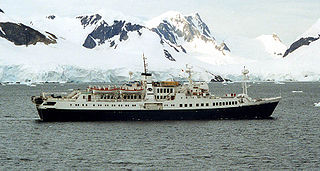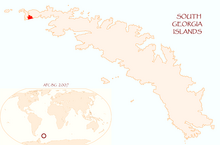
Joinville Island is the largest island of the Joinville Island group, about 40 nautical miles long in an east–west direction and 12 nautical miles wide, lying off the northeastern tip of the Antarctic Peninsula, from which it is separated by the Antarctic Sound.

Rongé Island is a high, rugged island 5 nautical miles long, the largest island of the group which forms the west side of Errera Channel, off the west coast of Graham Land in Antarctica.

Stromness Bay is a bay 3 miles (4.8 km) wide, entered between Cape Saunders and Busen Point on the north coast of South Georgia. Stromness Bay, like Leith Harbour takes its name from a location in Scotland, Stromness, on the Orkney Mainland. This is partially because both places called Stromness were whaling centres. The headland forming the southeast side of the entrance to Stromness Bay is named Busen Point. Bucentaur Rock lies close northeast of Busen Point.

The Arctowski Peninsula is a peninsula, 15 nautical miles long in a north-south direction, lying between Andvord Bay and Wilhelmina Bay on the west coast of Graham Land, Antarctica.

The Willis Islands are a small archipelago to the west of South Georgia Island in the South Georgia Islands. They are 2 miles (3.2 km) west of Bird Island, separated by the Stewart Strait. They were discovered on 14 January 1775 by Captain James Cook and named for Cook's midshipman Thomas Willis, the crew member who first sighted them. The Willis Islands were charted in greater detail and individually named by Discovery Investigations (DI) personnel between 1926 and 1930.

Hound Bay is a bay at the base of Barff Peninsula. It is 2.5 miles (4 km) wide at its mouth and recedes 3 miles (5 km), entered between Tijuca Point and Cape Vakop along the north coast of South Georgia. The names "George Bay" and "Hundebugten" have appeared on charts for this feature. The South Georgia Survey (SGS) of 1951–52 reported that this bay was better known to whalers and sealers as "Bikjebugten". The name Hound Bay, proposed by the UK Antarctic Place-Names Committee (UK-APC) is an English form of this name.

Barff Peninsula is a peninsula forming the east margin of Cumberland East Bay, South Georgia Island. It is 8 miles (13 km) long and extends northwest from Sörling Valley to Barff Point, its farthest extremity. It was probably first seen by the British expedition under James Cook in 1775. The peninsula as a whole takes its name from Barff Point, which was named for Royal Navy Lieutenant A.D. Barff of HMS Sappho, who, assisted by Captain C.A. Larsen, sketched a map of Cumberland Bay in 1906. Barff Point is considered the eastern headland of East Cumberland Bay.

Cumberland West Bay is a bay forming the western arm of Cumberland Bay, South Georgia. It is entered southward of Larsen Point, where it is 2.5 miles (4 km) wide and extends 7 miles (11 km) in a southwest direction. It is separated from Cumberland East Bay by Thatcher Peninsula. Papua Beach is situated on its southeast shore.

The Bay of Isles is a bay 9 miles (14 km) wide and receding 3 miles (5 km), lying between Cape Buller and Cape Wilson along the north coast of South Georgia. It was discovered in 1775 by a British expedition under James Cook and so named by him because numerous islands lie in the bay. Of South Georgia's 31 breeding bird species, 17 are found here.
Jason Harbour is a bay 1 mile (1.6 km) wide, lying west of Allen Bay in the north side of Cumberland West Bay, South Georgia. It was charted and named by the Swedish Antarctic Expedition, 1901–04, under Otto Nordenskiöld. The bay was previously visited by the Jason, Captain C.A. Larsen, in 1894.
Jomfruene is a group of three small tussock-covered islands and a number of barren rocks, lying 1 nautical mile (2 km) west-northwest of Cape Paryadin, South Georgia. The position and number of these islands have been approximated on charts for years. In 1951–52, the South Georgia Survey (SGS) reported that the single large island, shown on charts as "Three Point Island," was known locally as Jomfruene. Following more detailed survey by the SGS, 1955–56, it is now known that there are three small islands, not one large one, and the local name has been extended to the group.

Moraine Fjord is an inlet 3.5 nautical miles long with a reef extending across its entrance, forming the west head of Cumberland East Bay, South Georgia. It was charted by the Swedish Antarctic Expedition under Otto Nordenskjöld, 1901–04, who so named it because of the large glacial moraine at its entrance.

Elsehul is a bay along the north coast of South Georgia Island in the southern Atlantic Ocean. Elsehul is approximately 0.5 miles (0.8 km) wide, and is separated from nearby Undine Harbour by the narrow Survey Isthmus. The name "Elsehul" dates back to the period 1905–12 and was probably applied by Norwegian sealers and whalers working in the area. The Discovery Investigations (DI) expedition of 1930 surveyed Elsehul and the surrounding area, naming many features. A British Admiralty chart dating to 1931 provided the first instance of many other names; unless otherwise specified, features noted in this article were first named on this chart.
Cook Bay is an irregular bay, 1.3 nautical miles (2.4 km) wide at its entrance between Cape Crewe and Black Head, narrowing into two western arms, Lighthouse Bay and Prince Olav Harbour, along the north coast of South Georgia. It was charted by Discovery Investigations (DI) personnel during the period 1926–30, and named by them for Captain James Cook, who explored South Georgia and landed in this general vicinity in 1775.
Greene Inlet is an inlet immediately northwest of Cape Paryadin at the west end of South Georgia. The name "Deep Inlet" was probably given by Lieutenant Commander J.M. Chaplin, Royal Navy, of the Discovery, during his survey of the Undine Harbour area in 1926 but it is not used locally. The South Georgia Survey, 1951–52, reported that the feature requires a name, but that Deep Inlet is not sufficiently distinctive, being descriptive of so many features at South Georgia. Greene Inlet is named for Daniel Greene of New Haven, CT, who in 1790 commanded one of the first two American sealing vessels to visit South Georgia.

Paradise Harbour is a wide embayment behind Lemaire Island and Bryde Island, indenting the west coast of Graham Land, Antarctica, between Duthiers Point and Leniz Point. The name was first applied by whalers operating in the vicinity and was in use by 1920.
For the point in Barbados, see Harrison Point, Barbados
Semla Reef is a reef, 1 nautical mile (1.9 km) long, at the south side of the entrance to Queen Maud Bay on the south side of South Georgia. Surveyed by the SGS in the period 1951–57, and named by the United Kingdom Antarctic Place-Names Committee (UK-APC) for the ex-catcher Georgia Whaling Co., Leith Harbor, as a service boat.
Mount Regulator is a mountain, 655 m, standing 1 nautical mile (1.9 km) west of Right Whale Bay on the north side of South Georgia. Surveyed by the SGS in the period 1951–57, and named by the United Kingdom Antarctic Place-Names Committee (UK-APC) for the Regulator. The Regulator was an American sealing ship that was wrecked during the 1799–1800 season. The crew was rescued by an unknown British sealing ship. Captain Edmund Fanning of New York returned during the next season and found deserted shelters at Right Whale Bay, built by the crew of the Regulator before their rescue.
Bryde Island is an island 6 nautical miles long and 3 nautical miles wide, lying immediately southwest of Lemaire Island, off the west coast of Graham Land, Antarctica.













